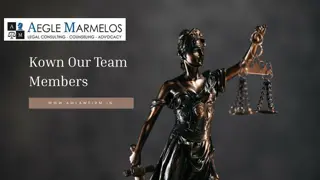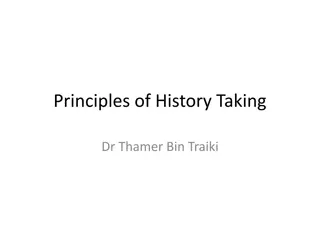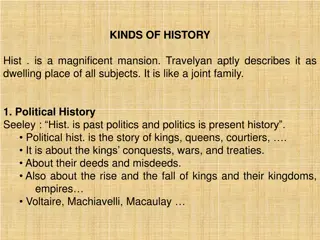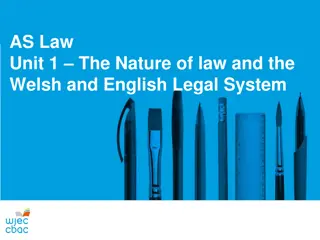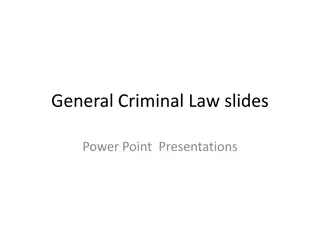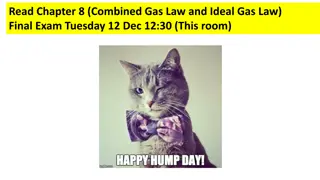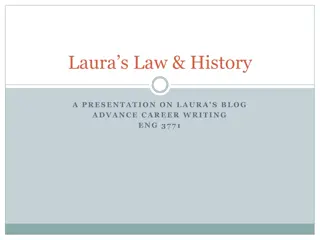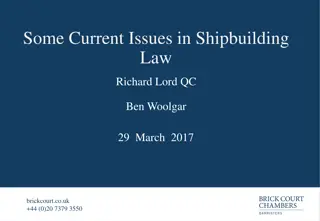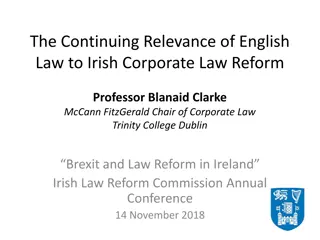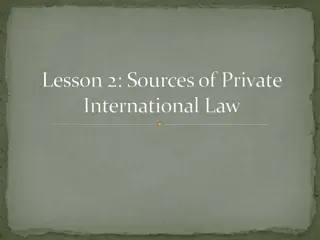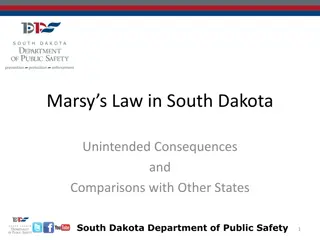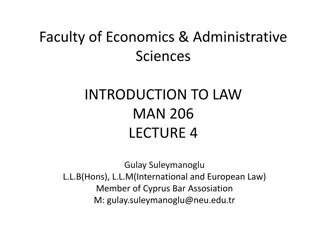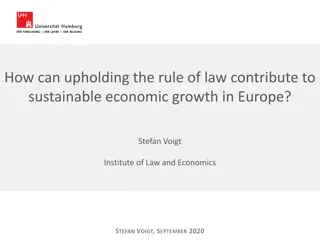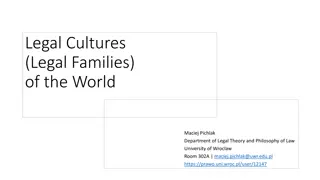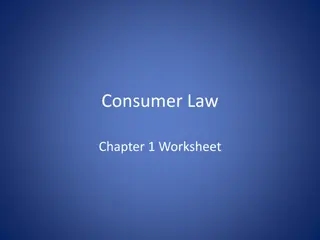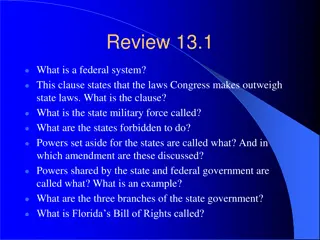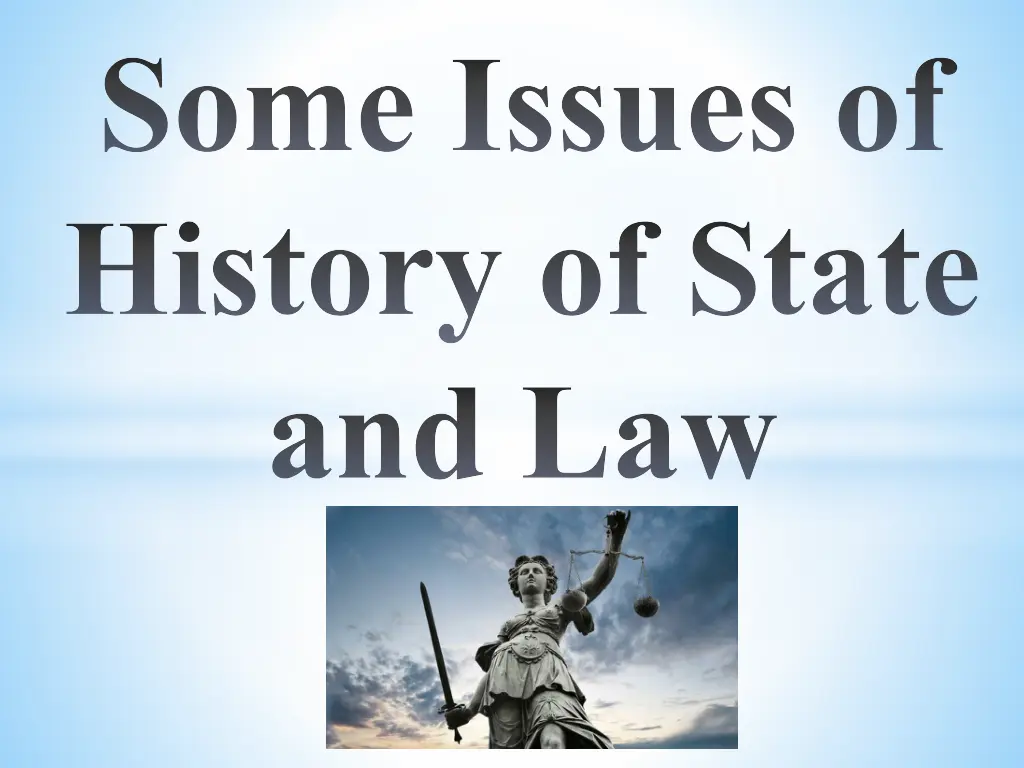
Origin and Development of State and Law
Explore the intertwined history of state and law, delving into how they evolved over centuries from primitive communal societies to complex modern civilizations. Uncover major theories on the emergence of state and law, Russian attitudes towards legal norms, and the transition from tribal organizations to structured state systems. Witness the gradual shift from customary regulations to written laws as societies progressed and complexities arose.
Download Presentation

Please find below an Image/Link to download the presentation.
The content on the website is provided AS IS for your information and personal use only. It may not be sold, licensed, or shared on other websites without obtaining consent from the author. If you encounter any issues during the download, it is possible that the publisher has removed the file from their server.
You are allowed to download the files provided on this website for personal or commercial use, subject to the condition that they are used lawfully. All files are the property of their respective owners.
The content on the website is provided AS IS for your information and personal use only. It may not be sold, licensed, or shared on other websites without obtaining consent from the author.
E N D
Presentation Transcript
Some Issues of History of State and Law
GENERAL QUESTIONS: 1.How did the state and law come about? (3-6) 2.Major theories of the emergence of the state and law (7-19) 3.Russian attitude to law and to the implementation of legal norms and principles (20-21) 4.Russian constitutions (22-43)
The state and law are intimately interconnected: The state (its relevant bodies) adopts laws and guarantees their implementation; Law establishes binding rules for the activities of state bodies and the behavior of its officials; Therefore, scholars consider their origin as a combined and interdependent phenomenon.
How did the state and law come about? There is a lot of different opinions but the following is for sure: The process of their formation took more than one century; In the primitive society labor productivity was low, property was communal, and labor was collective; Public relations were regulated and stabilized by custom; There was no need for the state and law.
The need for the state and law arose because of the progress and complication of society: It was necessary to regulate family relations as the tribe consisted not only of relatives, but also of newcomers who were not connected with others through kinship; The increasing complexity of public life has led to the emergence of a third force capable of judging disputes and conflicts between the contending parties and the state has become such a force; The state replaced the tribal organization; The written law first supplemented the customs and then acquired paramount importance;
The need for the state and law arose because of the progress and complication of society: The basis of the state system was no longer a kinship, but a territorial division; A special group of people appeared who were professionally engaged in command and control using special units of armed people, prisons, and regular army to impose their will on the people; The population began to pay taxes for the maintenance of the state apparatus; Outstanding representatives of the ruling class worked out laws often explaining their emergence by the will of God.
The theological theory of the emergence of the state and law: Came into being before other theories; Is directly related to religious ideas about the origin of the world; States that if God created the world, then the state and law are also created after His will; State power is eternal and unshakable; In the Middle Ages, this theory was further developed, in particular, by the philosopher and theologian Thomas Aquinas (1225-1274).
The patriarchal theory: Had been developed by the ancient Greek philosopher Aristotle (384-322 BC); Regards the birth of the state as the development of a family; In a family, the father is the head, while in the country-state the monarch, who is obliged to take care of his subjects, just as a good father is called to take care of children and household members; Monarchical state power has a divine origin.
The theory of the contract: Had been advocated by G. Grotius (1583- 1645), B. Spinoza (1632-77), T. Hobbes (1588-1679), J. Locke (1632-1704), J. J. Russo (1712-78), A. N. Radishchev (1749- 1802); Defines state power as a result of the union of people who have concluded a mutual voluntary agreement (social contract) with each other; The state and law are considered as a product of the will and activity of the people;
The theory of the contract: Having concluded the contract, people transferred a part of their natural rights to the state, and the state undertook to protect the property and security of citizens and the nation; The state thus acquired legal force by the will and consent of the people; If the government violates the contract with the people, the latter have the right to overthrow it.
The theory of violence: Was formed in the XIX-XX centuries in the works of E. D hring (1833- 1921), K. Kautsky (1854-1938), and other politicians and scholars; State power arises as a result of political and military events, the conquest of some tribes and peoples by other tribes and peoples;
The theory of violence: The state is a special coercive apparatus created to rule over the vanquished; The very conquest of some peoples by others is seen as a form of submission of the weak by the strong, an eternal and unchanging law of nature; Proponents of this theory absolutize the role of violence in history and ignore other ways of forming states.
The organic theory: Is presented in the writings of Plato (427-347 BC), Aristotle, H. Spencer (1820-1903), and other thinkers; The structure and functions of the state are likened to the corresponding manifestations of a living organism; E.g. Aristotle believed that the existence of a person outside the state is as impossible as the existence of arms and legs separated from the body;
The organic theory: Spencer compared people living in the state to cells that make up a living organism; States develop, evolve, and age like organic beings; If and when some cells are sick, the whole body suffers; The same is true about the state: its strength is entirely dependent on the mental and physical health of its citizens.
The psychological theory: Exists since the mid-19th century; Its representatives are Z. Freud (1856-1939), L. Petrazhitsky (1867-1931), and others; Explains the state and legal mechanisms by special psychological experiences and needs of people, e.g., the desire for power, the need to live in an organized society; Supporters of this theory believe that some people tend to dominate, while others obey outstanding personalities; In the state and law, they see means of pacification of aggressive drives inherent in individuals from the birth.
The racial theory: Proceeds from the false division of peoples into higher (masters) and lower (slaves) races; The qualities that determine their status are innate; J. Gobino (1816-82), one of the founders of the racial theory, considered the Aryans (peoples belonging to the Indo-European linguistic community) as a higher race;
The racial theory: The Nazis attributed the Germanic peoples, the heirs of the ancient Romans , to the Aryans; They called the Slavs, Jews, Arabs, and other peoples the lower race; In the writings of supporters of this theory, history, formation, and growth of states are depicted as a result of the struggle of the Aryans against the lower races .
The materialistic (Marxist) theory: Its creators are K. Marx (1818-83), F. Engels (1820-95), V. Lenin (1870-1924); The main reasons for the emergence of the state and law they saw in the field of economic relations; In the course of economic development, primitive society evolved to the state, from customs as the only form of regulation of social life to law; The stratification of society into rich and poor led to its division into the ruling elite and the mass of dependent people;
The materialistic (Marxist) theory: Society split into classes which ultimately required the emergence of the state and law protecting the interests of the ruling classes, the elite; The followers of Marxist views maintain that the state is the result of the intransigence of class contradictions; They believe that after the liquidation of the exploiting classes (landowners, capitalists, etc.) the need for the state will disappear.
The attitude to law and to the implementation of legal norms and principles, inherent in the Russian people, is marked by significant originality: Russian Orthodoxy has placed the religion of grace above the religion of law; The best Russian rulers tried to follow, above all, moral law, the commandments of Holy Scripture; The written law was valued less than the moral law;
The attitude to law, to the implementation of legal norms and principles, inherent in the Russian people, is marked by significant originality: The underestimation of the written law had its downside: Attempts to strengthen the rule of law, undertaken in different periods of Russian history, ran into distrust of broad strata of the people as they were perceived by them as legal chicanery.
Russian Justice: Was the legal code of Kievan Russia; Was written in 1016 and remade during the centuries of feudal division; Was a main source of Old Russian Law; Despite great influence of Byzantine legislation and commercial ties between Byzantium and Kievan Russia, Russian Justice bore no similarity to that of the Byzantine Empire: The absence of capital and corporal punishment reflects the Scandinavian ways.
The Legal Code of 1497: Was a collection of laws introduced by Ivan III in 1497; Played a significant role in the centralization of Russia, creation of the nationwide Russian Law and elimination of feudal division; Took its roots from Old Russian Law, including Russian Justice, Legal Code of Pskov, princely decrees, and common law, the regulations of which were upgraded with reference to social and economic changes; Established a universal system of the judicial bodies, defined their competence and subordination, and regulated legal fees;
The Legal Code of 1497: Expanded the range of acts, considered punishable by the standards of criminal justice e.g., sedition, sacrilege, slander; Established the investigative nature of legal proceedings; Provided different kinds of punishment, such as death penalty, flagellation etc.; In order to protect feudal landowners, it introduced a fee for peasants who wanted to leave their feudal lord and established a universal day (November 26) for peasants, who wanted to switch their masters (St Yuri s Day).
The Legal Code of Tsar Ivan IV: Was an expansion and revision of the Legal Code of 1497; Liquidated the aristocracy s judicial privileges and strengthened the role of state judicial bodies; Provided for the active participation of the elective representatives of local communities in legal proceedings; The arrest of suspects could be made only at the consent of the local community;
The Legal Code of Tsar Ivan IV: Town and rural communities had the right to self-management and the distribution of taxes; Confirmed the right of peasants to leave their feudal lords; Law precisely defined that the peasant had the right to leave the landowner after the payment of an exit fee.
The Council Code: Was a legal code adopted in 1649 by the Assembly of the Land under Tsar Alexis as a replacement for the Legal Code of Tsar Ivan IV; Survived well into the 19th century (up to 1849), when it was revised under the guidance of Mikhail Speransky;
The Council Code: Consolidated Russia s slaves and free peasants into a new serf class and declared it hereditary unchangeable; Prohibited travel between towns without an internal passport; Russian nobility: Agreed to serve in the army; Were granted the exclusive privilege of owning serfs.
The Code of Laws of the Russian Empire: Is an official publication of the existing legislative acts of the Russian Empire arranged in a thematic order, prepared under the guidance of M. Speransky in mid-19thcentury and republished until the October Revolution; Consisted of 15 volumes, including basic laws, legislation on provincial institutions, public finance, rights of state, administrative, civil, and criminal law; In addition to individual editions of volumes of the Code of Laws, there were also sequels to the Code: In 1892, the 16thvolume was added, in which the laws on legal proceedings were highlighted;
The Code of Laws of the Russian Empire: Adopted as a result of attempts by the Russian supreme power since the beginning of the 18th century to systematize legislation, the Code of Laws marked a new stage in the history of the domestic law; Replaced many regulations scattered in various sources and often unknown to the law enforcement officers for an orderly collection of laws available to all state bodies and subjects of the empire and thus becoming an important means of ensuring the rule of law;
The Code of Laws of the Russian Empire: An outstanding achievement of Russian legal thought of the 19th century, it generalized and formulated many legal norms and contributed to the formation of the Russian legal system; However, the compilers of the Code had no opportunity to make fundamental changes to the laws incorporated into it: As a result, the Code was cumbersome, archaic, incomplete and contained a number of contradictory legal norms.
The Russian Constitution of 1906: Was a major revision of the 1832 Code of Laws of the Russian Empire; It transformed the formerly absolutist state into one in which the emperor agreed for the first time to share his autocratic power with a parliament; Was enacted on 6 May 1906, on the eve of the opening of the first State Duma; It was granted during the Russian Revolution of 1905, in a last-ditch effort by the imperial government to preserve its own existence and keep the nation from sliding into all-out anarchy;
The Russian Constitution of 1906: Provided for a bicameral Russian Parliament, without whose approval no laws were to be enacted in Russia; This legislature was composed of an upper house, known as the State Council, and a lower house, known as the State Duma; Half of the members of the State Council were appointed by the Tsar, while the other half were elected by various governmental, clerical, and commercial interests; Members of the State Duma were to be chosen by different classes of the Russian people through a complex scheme of indirect elections with the system being weighted to ensure the ultimate preponderance of the propertied classes;
The Russian Constitution of 1906: While the Duma held the power of legislation and the right to question the Tsar s ministers, it did not have control over their appointment or dismissal, which was reserved to the monarch alone; The Duma could not alter the constitution, save upon the emperor s initiative; The Tsar retained an absolute veto over legislation, as well as the right to dismiss the Duma at any time, for any reason he found suitable; The Tsar also had the right to issue decrees during the Duma s absence, though these lost their validity if not approved by the parliament within two months.
The Constitution of Russia of 1918, also called the Basic Law, which governed the Russian Soviet Republic: Described the regime that assumed power in the October Revolution of 1917; Was ratified soon after the Declaration Of Rights Of The Working And Exploited People; Technically recognized the working class as the ruling class of Russia according to the principle of the dictatorship of the proletariat, thereby making the Russian Soviet Republic the world s first constitutionally socialist state.
The 1924 Constitution: Was the first constitution of the Soviet Union; Legitimized the December 1922 Treaty on the Creation of the USSR founding the Soviet Union; The Constitution had 72 articles divided into 11 chapters; It replaced the Constitution of 1918 which served as a precursor and influenced the main principles of the Union-wide constitution;
The 1924 Constitution: Established the Congress of Soviets to be the supreme body of Soviet state authority, with the Central Executive Committee (CEC) having this authority during the interims and serving as the country s collective presidency; The CEC also elected the Council of People s Commissars, which served as the executive branch of the government;
The 1924 Constitution: The CEC was divided into the Soviet of the Union representing the constituent republics, and the Soviet of Nationalities representing directly the interests of nationality groups; The Presidium supervised the government administration between sessions of the CEC.
The 1936 Constitution of the USSR (the so-called Stalin s Constitution): Was the constitution of the Soviet Union adopted on 5 December 1936; Was the second constitution of the USSR and replaced the 1924 Constitution; Redesigned the government of the Soviet Union: The Congress of Soviets replaced itself with the Supreme Soviet, which amended the 1936 Constitution in 1944;
The 1936 Constitution of the USSR (the Stalin s Constitution): Nominally granted all manner of rights and freedoms, and spelled out a number of democratic procedures; Asserted the leading role of the All-Union Communist Party (Bolsheviks) and legally cemented the totalitarian control of the party by General Secretary Joseph Stalin preceding the Great Purge.
The 1977 Constitution of the USSR: Was adopted on 7 October 1977; Is also known as the Brezhnev s Constitution or the constitution of the developed Socialism, was the third and final Constitution of the USSR; Replaced the 1936 Constitution and stated that the aims of the dictatorship of the proletariat having been fulfilled, the Soviet state has become the state of the whole people and no longer represented the workers and peasants alone; Chapter 1 defined the leading role of the Communist Party and established the organizational principles for the state and the government;
The 1977 Constitution of the USSR: Article 1 defined the USSR as a socialist state, as did all previous constitutions; Was long and detailed, including 28 more articles than the 1936 Constitution; Explicitly divided responsibilities between the Central Government and the governments of the republics; Included Article 72, granting the official right of constituent republics to secede from the Union promised in previous constitutions;
The 1977 Constitution of the USSR: Articles 74 and 75 stated that when a Soviet constituency introduced laws in contradiction to Supreme Soviet, the laws of the latter would supersede any legal difference; The Union law regulating the secession was not provided until the last days of the USSR; Was repealed upon the dissolution of the USSR on 21 December 1991 and the post- Soviet states adopted new constitutions.

